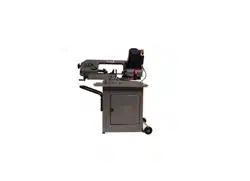Loading ...
Loading ...
Loading ...

12
7.5 Downfeed stop
The weight of the bow guides the blade through the
workpiece. The stop screw (G, Figure 7-3) prevents
blade from contacting base after the cut. It has been
adjusted by the manufacturer. If future adjustment is
needed, loosen hex nut and rotate screw then
retighten hex nut.
7.6 Limit switch stop
The limit switch stops the blade after cut has been
completed and bow has reached down position.
To adjust, loosen hex nut and turn screw (H, Figure
7-3). A distinct “click” will be heard when limit switch
engages. Tighten hex nut against plate to secure
screw setting.
7.7 Bow prop
Use prop (J, Figure 7-3) to keep bow in raised
position.
7.8 Vise adjustment
Keep hands away from blade
while moving or adjusting vise.
7.8.1 Miter cutting
The base has two sets of holes for mounting vise
assembly. For miter cuts from 0° to 45°, mount vise
assembly to rear set of holes. For miter cuts over
45° up to 60°, mount vise to front set of holes. See
Figure 7-4.
Figure 7-4
To adjust vise to 60° position:
1. Disconnect band saw from power source.
2. Raise bow and secure with prop.
3. Remove two screws and washers on vise
assembly with 6mm hex wrench, and move
assembly to other set of holes. Tighten screws
securely.
4. Remove stop screw (D, Figure 7-2) and swivel
bow until pointer lines up with 60° on scale.
Tighten handle (B, Figure 7-2).
Note: If handle becomes too constrained to be
easily tightened while at 60° position, lift up on
handle and use hex wrench to tighten the pin,
then fully tighten using the handle itself. See
Figure 7-5.
The cutting operation will now take place on
opposite side of vise. Install chip tray and/or work
stop to opposite side of vise.
Figure 7-5
7.8.2 Workpiece clamping
Place workpiece against fixed jaw which has
already been squared (see sect. 7.2). Rotate
handwheel clockwise to clamp floating jaw against
workpiece, counterclockwise to release.
For irregular-shaped workpieces, loosen screw on
floating jaw, bring jaw into contact with workpiece to
conform to shape, then tighten screw.
7.9 Blade tension
1. Disconnect band saw from power source.
2. Remove back blade cover by removing knob
and two screws. Inspect position of blade on
wheel. If blade is not adjacent to wheel flange,
first adjust blade tracking according to sect.
7.10, then proceed to step 3.
3. Turn blade tension knob (K, Figure 7-6)
clockwise to tighten blade. Pluck the blade with
your finger; a tensioned blade will emit a
“twang” sound.
For precise measurement, use a blade tension
gauge (not provided). Hard-back blades are
generally tensioned at about 25,000 PSI (1757
kg/cm
2
); bi-metal blades at about 35,000 PSI
(2460 kg/cm
2
).
4. Perform cutting operations with the saw, and
make further tension adjustments as deemed
necessary. As experience with the saw is
Loading ...
Loading ...
Loading ...
